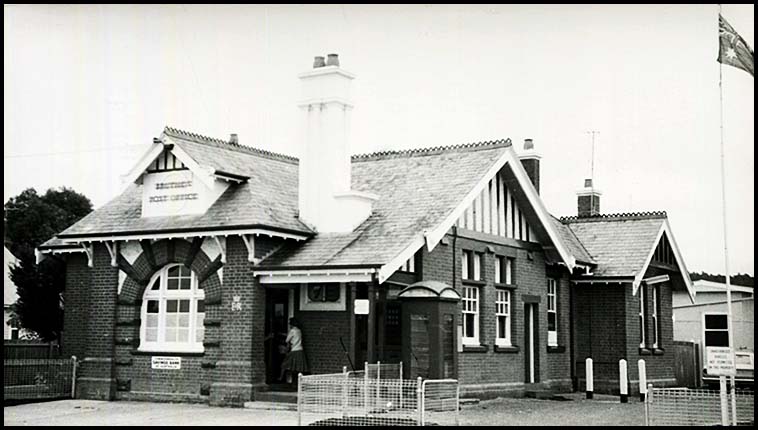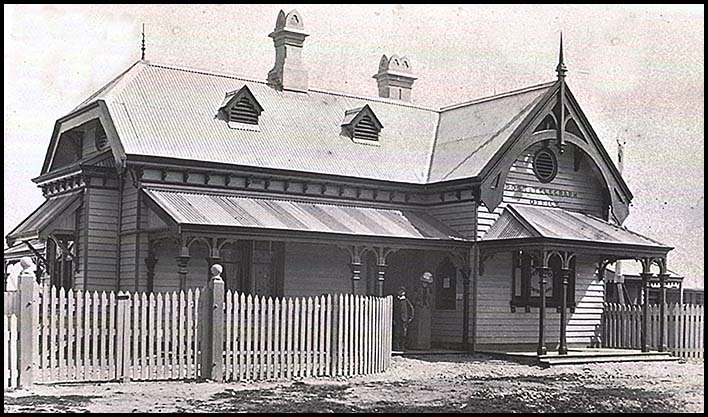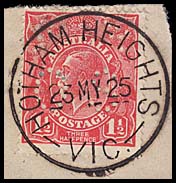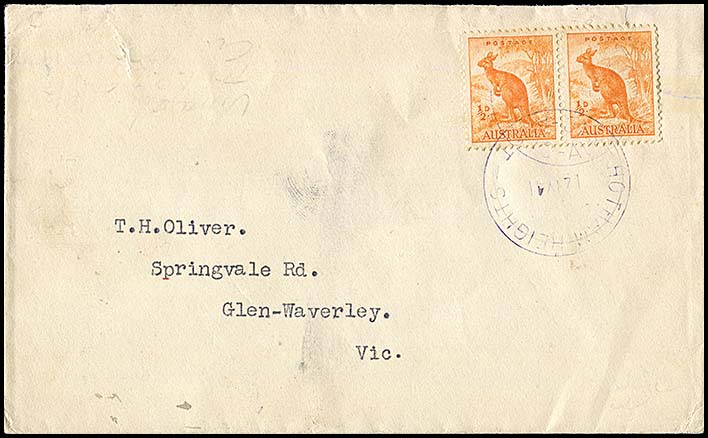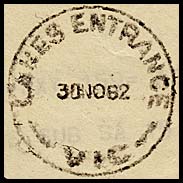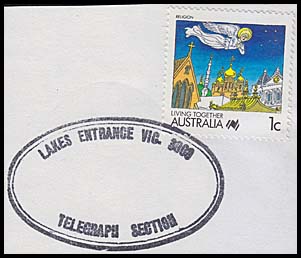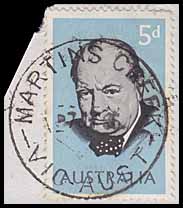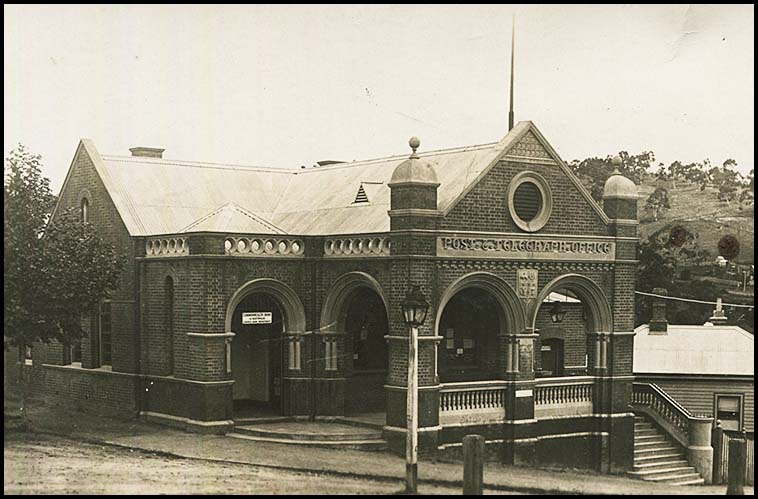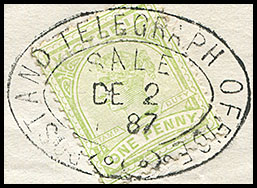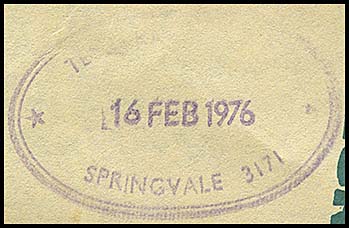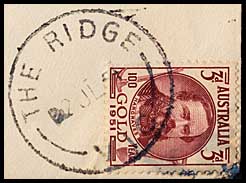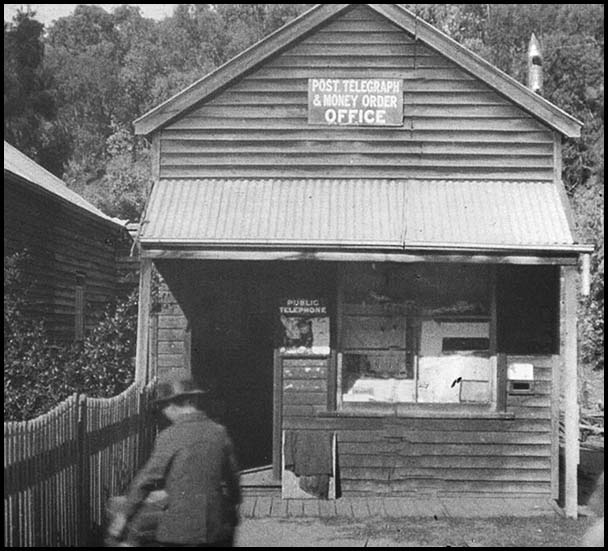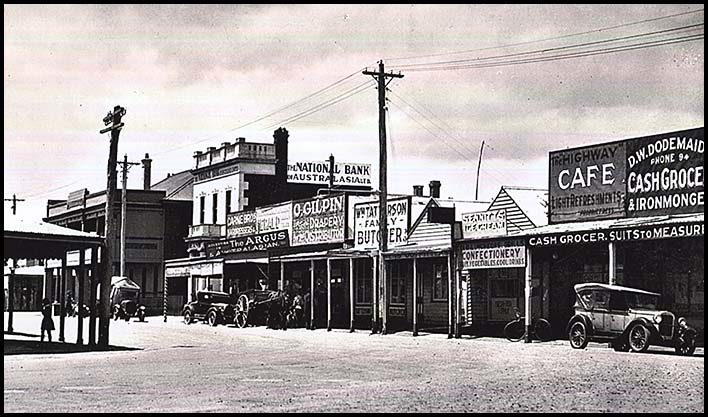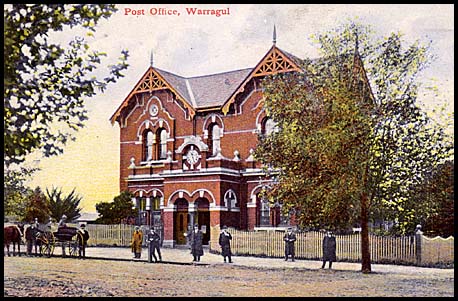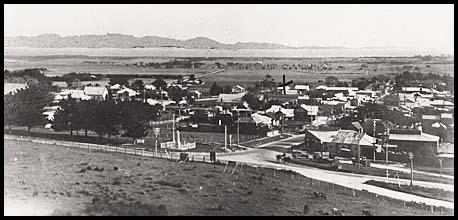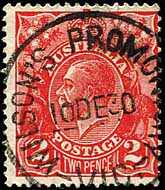Telegraph Offices on the Gippsland line and the Bairnsdale Branch.
- Home, index, site details
- Australia 1901-1988
- New South Wales
- Overview of NSW
- Telegraph lines
- Telegraph Offices
- Date stamps
- Forms
- Envelopes
- Rates
- Stamps
- Queensland
- Overview of Qld
- Telegraph lines
- Telegraph offices
- Date stamps
- Forms
- Envelopes
- Rates
- Stamps
- South Australia
- Overview of SA
- Telegraph lines
- Telegraph Offices
- Date stamps
- Forms
- Envelopes
- Rates
- Stamps
- Tasmania
- Overview of Tasmania
- General developments
- Reports
- Organisation
- Telegraph lines
- Telegraph Offices
- Date stamps
- Railway lines
- Forms
- Envelopes
- Rates
- Stamps
- Overview of Tasmania
- Victoria
- Overview of Vic.
- Telegraph lines
- Telegraph offices
- Date stamps
- Forms
- Envelopes
- Rates
- Stamps
- Ephemera
- Western Australia
- Overview of WA
- Telegraph lines
- Telegraph Offices
- Date stamps
- Forms
- Envelopes
- Rates
- Stamps
The Post & Telegraph Offices along the Gippsland line and the Bairnsdale branch are listed alphabetically and not by date of opening or by geographical sequence.
| Bairnsdale. On both the Gippsland line and the Bairnsdale Branch. The Telegraph Office opened in July 1869 after the Post Office had opened in February 1858 (on the east bank of the river in Lucknow) but soon relocated in April 1862. On 23 April 1875, £1,200 was apportioned by the Postmaster-General for the building of a new Post and Telegraph Office at Bairnsdale. Tenders were called in August 1875. By 1890, discussions and public meetings were well underway in relation to the building of a new Post and Telegraph building in a central position in Main Street. The Post Office was (sadly) demolished in 1970. |
Both these buildings were the design of architect A.J.Mcdonald of the Public Works Department. |
The Gippsland Times reported on 6 February 1884:
|
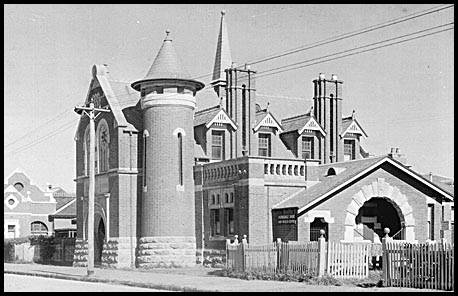 Bairnsdale's impressive Court House more recently - taken from the opposite side from the image above. The Post & Telegraph Office is at the left in the distance. |
The office was issued with three types of date stamp for use with telegraphs:
|
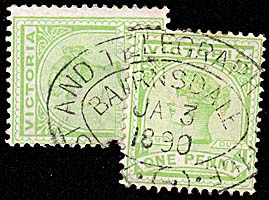 3 January 1890. |
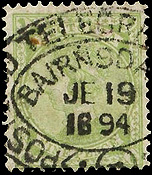 19 June 1894 (latest recorded date). |
Used in blue on 20 October 1891 and in 1892. |
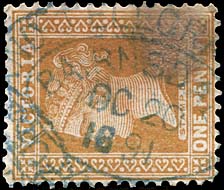 20 October 1891 (earliest recorded date for a blue version). |
|
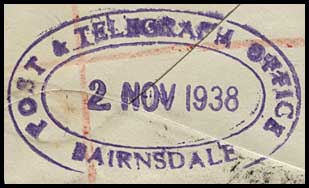 2 November 1938. |
 8 December 1951. Image courtesy of Brian Sampson. |
|
|
 2 April 1948. |
| The usual postal date stamp was also used on telegrams. | 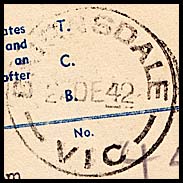 27 December 1942. Used on AW-DO-9A (41). |
| Bairnsdale Railway Station.
A Telegraph Office was also opened at the Railway Station about 1910. It was then reclassified as a Post Office about 1915 but reverted to a Telegraph Office about 1940. The Office was closed about 1966. A circular date stamp (RC2-VR) with the letters V.R. at the base was issued to the office.
|
 1 February 1955. |
| Berwick.
The Telegraph Office was opened in March 1873. |
|||
The office was issued with a circular rubber TELEGRAPH OFFICE date stamp (RC1-TO):
|
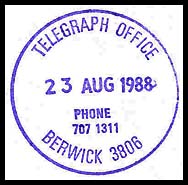 23 August 1988. (only recorded date). |
|
Located about half way from a line joining Omeo and Bairnsdale. A Telegraph Office was opened on 10 September 1936. It closed on 31 August 1961. |
|
| No date stamp sighted yet. | |
| Brown Coal Mine.
The Telegraph Office probably opened on 8 July 1918 at the same time as the Receiving Office was upgraded to a Post Office. The Receiving Office had opened on 3 September 1917. The name Brown Coal Mine was changed to Yallourn North on 1 August 1917. The office was destroyed by fire on 14 May 1934. Brown Coal is about 5 km NE Yallourn. |
||
A T.O. Brown Coal Mine date stamp was issued for use with telegraph business in two formats:
|
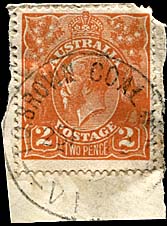 25 February 1922. |
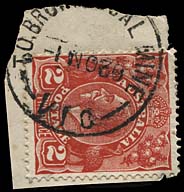 1 November 1930 (latest recorded date). |
|
 30 May 1936. |
|
| Bruthen.
The Telegraph Office was opened on 29 May 1880. The Bendigo Advertiser contained the following:"The opening of the office bring us within the pale of civilization. Three mails a week saved us from becoming heathens, but to be in a minute correspondence with the world makes a man feel happy and careless of city gaiety. We sent the deputy-postmaster a congratulatory message. In reply he thanked us, and hoped Bruthen would be benefited in every way. The receipts for the first day amounted to a goodly sum and, if the inaugural takings be an index for the future, the new office will pay". |
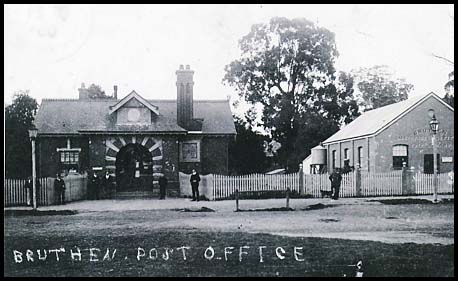 Early image of Bruthen Post Office - even perhaps before the Telegraph Office had been opened. Early image of Bruthen Post Office - even perhaps before the Telegraph Office had been opened.There is no telegraph pole at the right side. The front door is in the middle of the building. Image and details by courtesy of Brian Sampson of Bairnsdale. |
|
|
|
|
By 1886, the first postmaster of the Bruthen P&T office had been replaced. On 16 October 1886, the Bairnsdale Advertiser included the following article from its "own correspondent":
|
|
The Office at Bruthen was issued with a 1 hole Belt & Buckle date stamp.
|
 No date. |
|
A Telegraph Office was opened in March 1877 at Brandy Creek - not too far from Whisky Creek. The Warrugal Guardian of 4 October 1892 reported that:
|
||
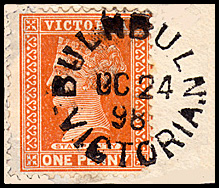 |
Buln Buln. Unframed date stamp |
|
|
The Telegraph Office was opened at Bunyip as part of the Railway Circuit in November 1877. Renamed from Bunyip R.S. on 14 September 1903. |
|||
 |
|
The Telegraph Office at Cann River was the second most easterly office behind Mallacoota East. It was established
The Office was issued with a T. O. date stamp. As changes were made to the date stamp, five formats were created. |
||
|
 20 April 1921. |
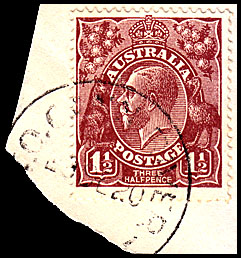 23(?) December 1920. |
|
||
|
 21 February 1928. Prestige Philately March 2006 Lot 831. |
|
|
||
|
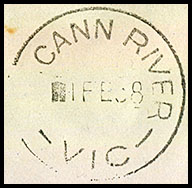 1 February 1938. |
|
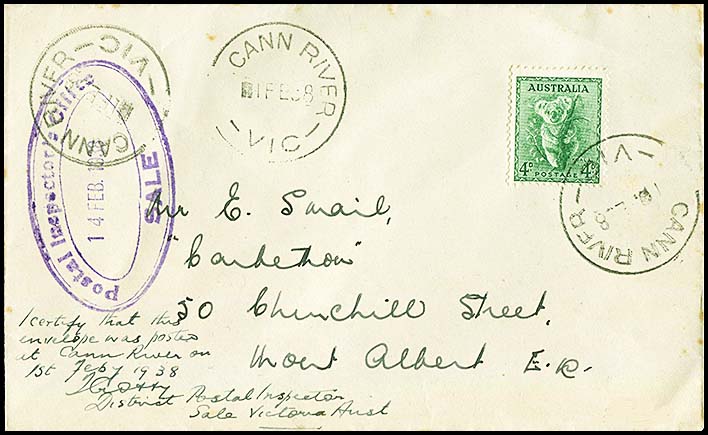 Cann River with T.O. removed - on cover to Mount Albert. 1 February 1938. Provenance: Gary Watson, Johnstone. |
||
Cranbourne. The Telegraph Office opened in February 1877. |
||
An oval date stamp inscribed TELEGRAPH (RO2 - T) was issued for use at the Telegraph Office.
|
 21 September 1988. |
|
|
The Telegraph Office was opened in June 1871. The Post Office was opened on 1 July 1848.
|
||
A 1 hole Belt & Buckle date stamp was issued to the Dandenong Post & Telegraph Office.
|
 24 February 1893 (earliest recorded date). |
|
A rubber oval POST OFFICE date stamp was used for telegraphic work.
|
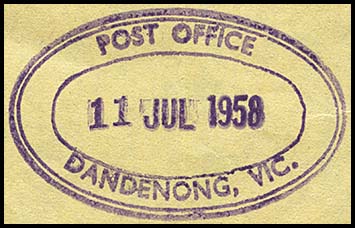 11 July 1958. Used on AA-DO-13A. |
|
| A Telegraph Office was also opened nearby at the Dandenong Railway Station about 1910 which was reclassified as a Post Office about 1915. | ||
| Drouin South.
A Telegraph Office was opened at Drouin South in February 1879 while the Post Office was opened on 1 September 1881. The establishment was closed on 31 August 1973. |
|
|
|
Rated: RR. |
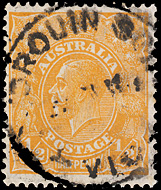 Date cannot be determined. |
|
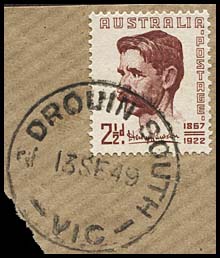 13 September 1949. |
|
|
|
|
|
Foster is 29 km south-east of Leongatha. The Telegraph Office was opened in April 1873. The Post Office was established when Stockyard Creek Post Office was renamed on 1 August 1879. |
|
|
|
A 1 hole Belt & Buckle date stamp was issued to Foster.
|
|
|
Gabo Island is an island of about 154 hectacres about 500 m off the coast of Victoria. It is about 14 km east of Mallacoota and near the border with New South Wales. The Lighthouse was completed in 1862. A Telegraph Office was opened about 1909. It was reclassified as a Post Office about 1915 but reclassified again back to a Telegraph Office about 1917. The Office was closed on 30 June 1964. |
|
A circular steel date stamp was issued to the Office.
|
 3 December 1960. |
|
The Post Office opened on 20 October 1890. The Office was reclassified as a Telegraph Office about 1936. The Office was closed on 31 August 1958 but the building was destroyed by fire in August 1959. Glen Wills is about 29 km north west of Omeo. |
|
No special date stamp for use with telegrams was issued to Glen Wills - the usual postal date stamp being used for telegram work. The usual postal date stamp with VIC at the base (diameter 29 mm, 5 mm side arcs and rated RR) was used from October 1916 to 5 February 1937 which is slightly into the Telegraph Office period. A replacement date stamp with VIC AUST at the base was then used. |
|
The date stamp used during the Telegraph Office period had VIC AUST at the base and 3 mm side arcs.
|
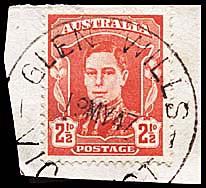 19 May 1947. |
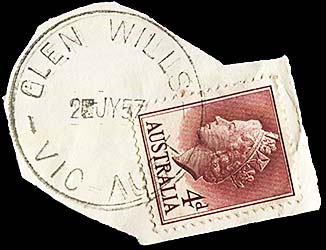 22 July 1957. |
|
| Glengarry.
Located about 8 km NNE of Traralgon. It was originally La Trobe Railway Station but renamed Glengarry on 1 December 1884. A Telegraph Office was opened about 1909 and closed about 1911. A Telegraph Office was then opened at the Railway Station on 11 August 1911. It was reclassified as a Post Office about 1915 and closed about 1916. |
||
The office was issued with a T.O. Glengarry date stamp.
|
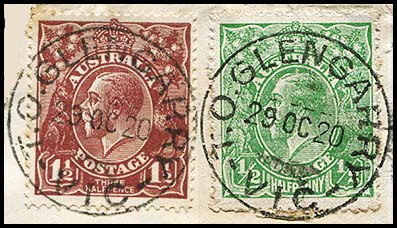 29 October 1920 (earliest recorded date). |
|
 1 April 1921. |
 25 February 1925. |
|
| Lake Tyers.
Lake Tyers opened as a Receiving Office in 1902 and was reclassified to a Post Office on 1 July 1927. It closed on 26 February 1971. Lake Tyers is along the coast and north east of Lakes Entrance.
|
||
The Receiving Office was issued with a TELEGRAPH OFFICE date stamp.
|
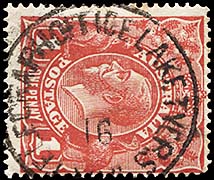 1916 - no day or month. Prestige July 2009 Lot 488. |
|
|
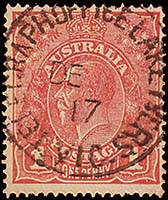 December 1917. |
|
|
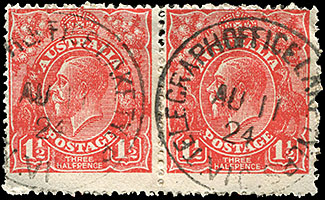 11 August 1924. |
 29 June 1925. |
|
The Telegraph Office was opened as Cunninghame in October 1879. Now called Lakes Entrance after a name change in January 1915. The Post Office opened in February 1870. An oval rubber datestamp for use with Telegrams was issued to Lakes Entrance but with no date line. |
|||
| Need a CUNNINGHAME |
On 9d Kangaroo on Map on telegram piece. |
Diameter: 28 mm. |
|
Size: 31 × 51 mm (e = 0.79). |
|||
| Leongatha.
The Post Office opened as Koorooman on 1 October 1887 and was renamed Leongatha on 1 June 1891 when a township was established on the arrival of the railway on 14 December 1891. The Telegraph Office opened before 1893. The telegraph line probably followed the railway line from Dandenong to Leongatha (maybe probably via Warragul and Mirboo) and then to Alberton (Railway Bill of 1884). Telegraph Offices were also opened at
|
||
 Leongtha Post & Telegraph Office looking north - about 1905. |
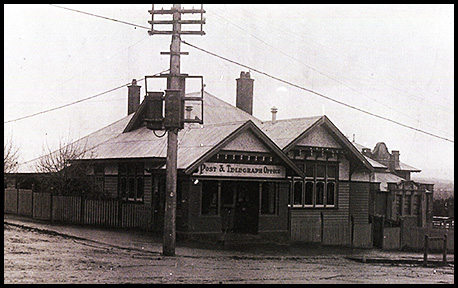 Leongatha Post & Telegraph Office about 1920. |
|
In the Mornington Journal of 15 March 1899, it was reported that
Nothing else is known of this initiative. |
 Leongatha about 1900 - Blair Street leading to the Post & Telegraph Office in the centre of the picture. A row of telegraph poles at the right leads to that building. |
|
The Leongatha Post and Telegraph Office is one of a small group of post offices, along with those in Terang (1903), Sorrento (1904), Korumburra (1904) and Woodend (1905), to be constructed for the Commonwealth by the Victorian government in the early years after Federation. These buildings were all designed and constructed by the Victorian Public Works Department under the supervision of its chief architect, J. H. Marsden - this despite the postal and telegraphic services being transferred to the Commonwealth from the states in 1901. After the early months of 1907, no further post offices were built in Victoria until 1909, when a concerted building campaign was commenced by the Commonwealth. Postal buildings were erected at at Canterbury, Hawthorn, Brunswick, and Beulah. Others followed in 1910, at Casterton, Birchip, Box Hill, Clifton Hill, Port Melbourne, Sandringham, Rupanyup, Violet Town and Willaura. More than a dozen additional premises were completed prior to the outbreak of World War I. Today the Leongatha Post and Telegraph Office is one of the oldest still functioning post offices built for the Commonwealth after Federation in 1901. |
||
Maffra. The Telegraph Office was opened in July 1875.
|
|||
|
The eastern most Telegraph Station in Victoria. Established on 1 March 1928 when the Post Office at Mallacoota changed name. In the following year, the Post Office at Mallacoota East was reclassified as a Telegraph Office and it operated until closed on 31 January 1940. |
| Marlo.
Marlo is on the Gippsland line to the east of Cunninghame (Lakes Entrance) and SE of Orbost. The office opened as a Receiving Office in 1902 and was upgraded to a Post Office on 1 July 1927. |
||
A TEL. OFFICE date stamp was used at Marlo.
|
 8 October 1915. |
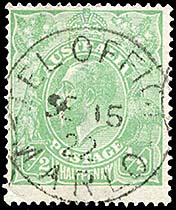 22 September 1922. Latest recorded date. |
| Moe.
The Telegraph Office was opened in January 1877 and another office at the Railway Station opening in July 1878.
|
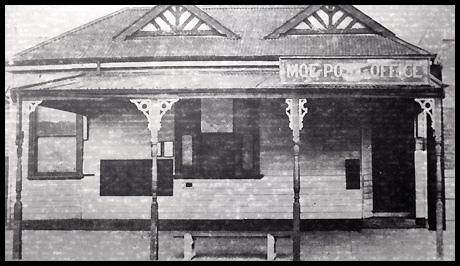 Moe Post & Telegraph Office about 1890. |
|
The office was issued with a one hole Belt and Buckle date stamp:
|
 10 August 1891. Provenance: Freeman, Johnstone. |
|
| Morwell.
The Telegraph Office was opened in August 1879. The Morwell Post & Telegraph Office needed replacement by 1882 as reflected in the following printed in the 23 August 1882 Gippsland Times:
|
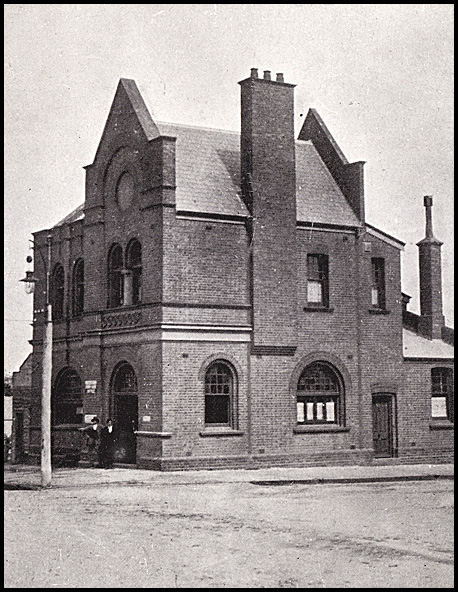 |
||
The office was issued with a 1 hole Belt and Buckle date stamp:
|
|||
|
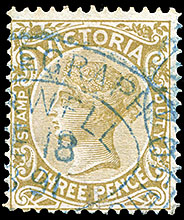 18 February 1891. Only example recorded. |
|
Situated in the Baw Baw region of Gippsland about 86 kms from Melbourne.
|
|
No special date stamp was issued to Nayook for use in the short Telegraph Office period . The ordinary Post Office date stamp was used instead.
|
 14 October 1949. |
|
The Telegraph Office |
|
The Office was issued with a rubber circular TELEGRAPH OFFICE date stamp (RC1-TO):
|
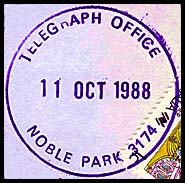 11 October 1988 (possibly last day of operation). |
|
The Telegraph Office was opened in September 1875. |
|
A TELEGRAPH date stamp RC1 - T was issued to the office - probably in the 1980s.
|
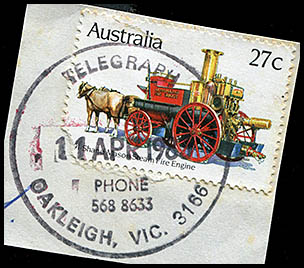 11 April 1983. |
| Omeo.
The Telegraph Office in Omeo opened in November 1879.
|
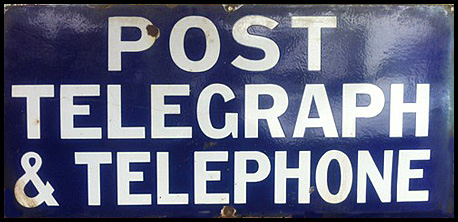 Sign allegedly from the Omeo P&T Office. Source: Ebay, July 2013. |
|
|
||
|
||
A 1 hole Belt & Buckle date stamp was used at Omeo:
|
 22 October 1891. |
|
 24 October 1893. On 9d apple green (1892 (printing). |
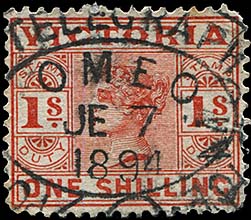 7 June 1894. |
|
|
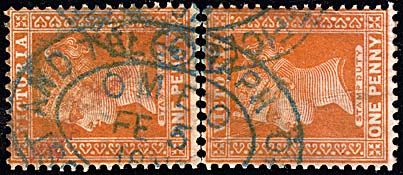 5 February 1889?. |
|
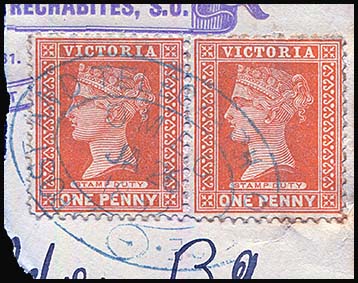 26 January, 1892. |
 12 September 1892. On 2/6 Stamp Duty. |
|
The following story was reported in the Ovens and Murray Advertiser of 1 January 1884 (p. 2):
|
||
|
The Telegraph |
|
The Telegraph Office was opened in August 1877.
|
|
The Telegraph Office was opened on 1 December 1864. On 25 January 1866, the Gippsland Times reported that " Mr. McGowan, the Superintendent of Telegraphs, is expected to arrive at the beginning of next month for the purpose of opening the new telegraph office and buildings which, when fully completed, will add greatly to the appearance of the seaport". Port Albert derives its present name from the husband of Queen Victoria. It was originally known, from 1841, as Seabank or Old Port which was changed to Alberton in 1842 and then to Port Albert in 1856. It was one of the first ports in Victoria and became the administrative centre of Gippsland. It was also the transport focus for goods transport between Melbourne and Tasmania. As such, there was a priority for Port Albert to have telegraphic communications. |
|
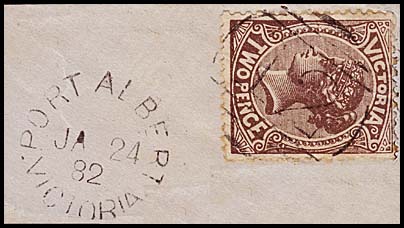 |
|
|
The Telegraph Office opened in January 1871. On the opening, Mr S. Hodder was appointed postmaster and line repairer. During the first year of operation, 442 messages were transmitted with revenue of £24 12s 10d - reflecting why the Government sought guarantees for the smaller offices. |
|
The Office was renamed from Springvale Railway Station Post Office on 20 October 1902. That Office had in turn been established on 1 February 1887. A Telegraph Office had also been established at the Railway Station about 1910 but it was closed as a separate office in February 1916. |
|
An oval Telegraph Section (RO-TS2) was issued to the office.
Although the words are indistinct, the inscription SECTION not OFFICE has been used because of the later inscription below and because the word following TELEGRAPH appears to be longer than 6 letters. No reference to this date stamp can be found elsewhere. |
|
A circular date stamp inscribed TELEGRAPH SECTION was issued to the Office during the 1980s.
The Postal Section of the Office had a similar date stamp (43 mm in diameter) with the top inscription being POST OFFICE. |
 |
|
The Telegraph Office opened on Friday 25 April 1873. |
|
Details unknown. It is about 1.5 hours NW from Bairnsdale.
|
 31 August 1966. |
|
The Telegraph Office was opened in June 1877.
|
|
Located south-west of Bairnsdale. A Telegraph Office opened at The Ridge in April 1923 when the Post Office, which had been opened on 7 November 1919, was changed in status. The Office closed on 31 May 1958. |
|
| No special date stamp for use with telegrams was issued to the Office - the usual postal date stamp being used: | |
|
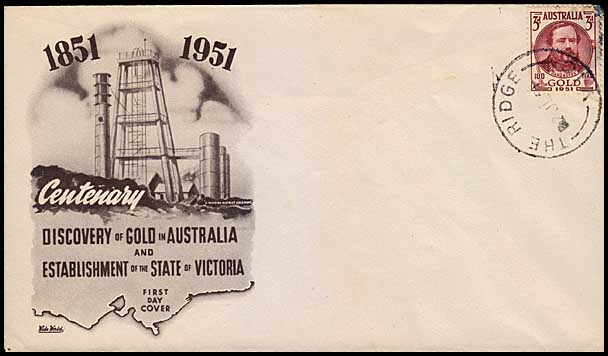 |
|
The Post Office opened on 1 July 1927 and was reclassified to a Telegraph Office on 8 July 1945. The Office was issued with a T.O. date stamp: |
||
|
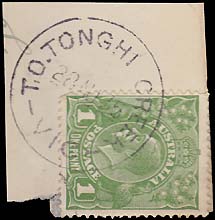 28 August 1935. 28 August 1935. |
|
|
 31 July 1934. |
|
|
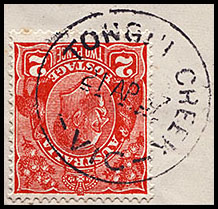 21 April 1937. |
|
|
||
|
Soth-east of Omeo. |
|
|
|
|
Little is known of this telegraph Office except it was opened in October 1883 (reported in the Kilmore Free Press (p. 2) of 18 October 1883). A Post Office had been opened on 2 June 1879. It operated until 1 June 1994 when it became a Licensed Post Office. |
|||||||||||||||||||||
|
|||||||||||||||||||||
John Hanley (of Trafalgar) has kindly provided copies of Australia Post records showing the Trafalgar office transmitted telegrams from 1883 to 1891. In the records, there are also two telegrams sent from Trafalgar to Melbourne on 9 June 1910 and on 26 June 1924. |
|
||||||||||||||||||||
|
A Telegraph Office was opened at the Railway station about 1910. It was closed about 1916. |
| Traralgon.
The Telegraph Office was opened at Traralgon in May 1875 - it is not known where. On 27 July 1882, "a deputation of Traralgon residents met the Postmaster-General and requested that a post and telegraph office should be erected at Traralgon. Mr. Bolton replied that as this year's estimates had now been placed before Parliament he could not accede to the request, so far as regards this year, but he would consider it favourably, and, if possible, place a vote for the post and telegraph office on next year's estimates." The Argus.
|
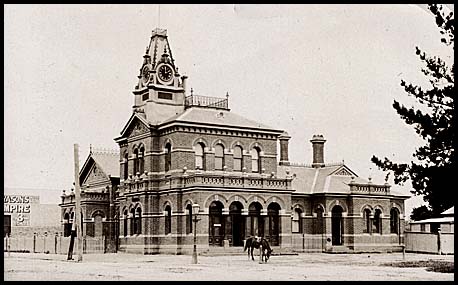 |
A subsequent deputation in April 1884 met with Mr. Berry, in his capacity of Postmaster-General
In April 1885:
On 18 November 1885:
The Traralgon Record of 6 November 1891 noted that
For a report on a Telegraphic Money Order fraud see elsewhere. |
|
A 1 hole Belt & Buckle date stamp was used at Traralgon;
|
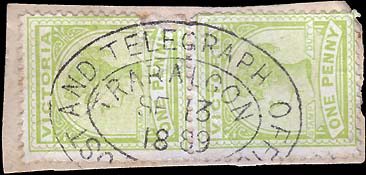 13 September 1889. |
|
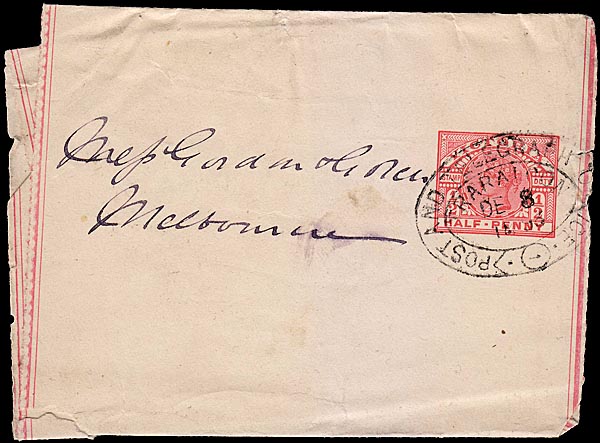 The 1 hole Belt & Buckle date stamp used in black on a wrapper on 8 December 1893 from Traralgon to Melbourne. |
| Walhalla.
Originally caller Stringer's Creek. The Telegraph Office opened in November 1870.
|
 Walhalla township about 1916. |
|
| A 2 hole Belt & Buckle date stamp was issued to the Office. Regarded as being one of the rarest Belt & Buckle datestamps.
|
 11 July 1888. |
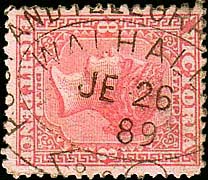 26 June 1889. |
.jpg) 29 May 1893. |
||
|
The Telegraph Office opened in June 1881. |
|
| The Office was issued with a 1 hole Belt & Buckle date stamp.
|
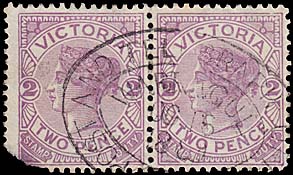 16 October 1889. |
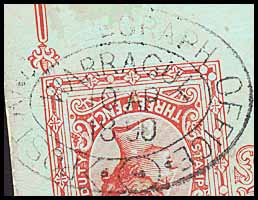 10 April 1890 (on a letter card). Note: day and month are reversed. Only recorded example. |
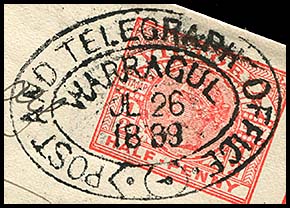 26 July 1889 (earliest recorded date). |
 |
|
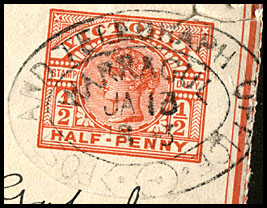 13 January 1893 (latest recorded date). |
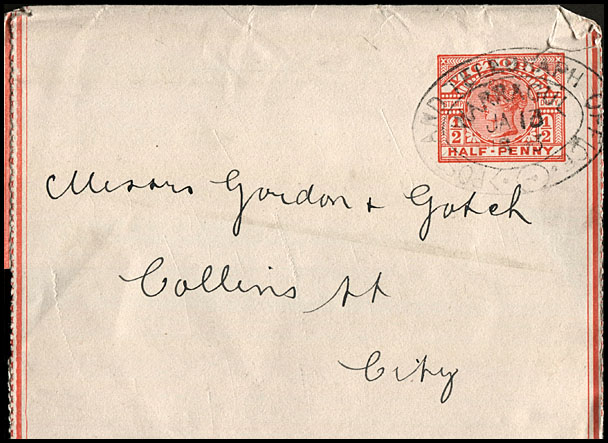 |
|
| Compete wrapper sent to Gordon & Gotch in Melbourne with the Warragul Belt & Buckle date stamp of 13 January 1893 (detail above). | ||
|
 9 July 1890. Stamps have been torn from the upper part of this cover. It has a blue rectangular REGISTERED hand stamp and an UNCLAIMED AT/ YINNAR in black. |
|
 9 July 1890. |
||
| A Telegraph Office had been opened at the Warragul Railway Station in March 1878. Premier Auctions notes it opened in 1910 and closed in 1970. |
|
A circular TELEGRAPH V.R. date stamp (RC2-T VR) was issued to the Office:
|
 1 February 1955. |
|
A Post Office was opened at Waterloo on 1 November 1860. On 20 December 1883 it was renamed Yarragon. A Telegraph Office opened at Waterloo in January 1880 or (according to a different source) opened 8 December 1965. It closed on 25 February 1969. 622 telegs sent in 1881. 792 in 1882. 343 sent and 323 rec in 1887. 461 sent in 1889. 524 sent in 1890. no telegs in 1884.
|
|
It appears that the Telegraph Office may have opened in 1879. The Annual Reports do not however indicate that year but infer the opening was in 1883. For example, there are no telegrams reported as being transmitted for 1880-82 but 603 were transmitted in 1884, 1682 in 1887, 1658 in 1889 and 1808 in 1890. John Hanley of Trafalgar has copies of Australia Post records showing telegraph usage from 1879 (624) to 1891 (1152). Further research is needed. There is also a belief that Yarragon Telegraph Office opened on the transfer of the Waterloo office. Both were clearly operating until at least 1890. A Telegram Office at the Yarragon Railway Station may have opened in 1889 - 30 telegrams were transmitted in 1889 with 72 transmitted in 1890. |
|
|
Located along the northern side of Strzlecki Ranges and is about 5-6 km south of Yarragon. There is also an understanding that Waterloo became Yarragon South not Yarragon but the date of such a transfer is not suggested anywhere. The Telegraph Office is reported as being opened on 22 December 1953 and closed on 18 April 1966. John Hanley (who has intimate knowledge of the situation) suggests that the Yarragon South Office operated as a telephone exchange but was never a Telegraph Office. Certainly in 1889, the office was still handling Postal and Money Order articles. |
|
The date stamp has T.O. in the upper inscription.
|
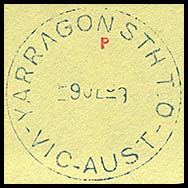 29 June 1953. |
| Yarram Yarram.
The Telegraph Office was opened in July 1882.
|
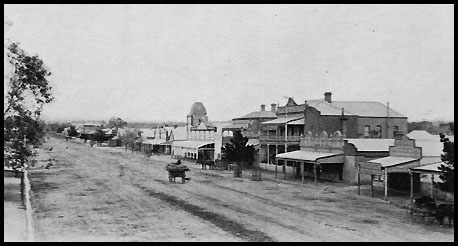 Yarram Yarram in 1909 showing Commercial Street. |
||
A two hole Belt & Buckle date stamp was issued to the office in Yarram Yarram:
|
 4 January 1891 (?). |
||
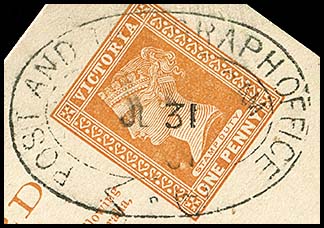 31 July 1891 (?) On PSE Lettercard for local delivery. |
|||
|
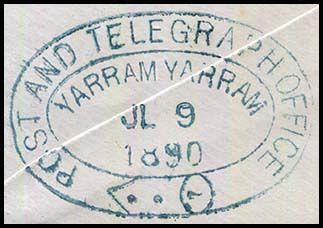 9 July 1890 (earliest recorded date). Two strikes (on front and back) on a 1d PSE for local delivery. |
||
 28 April 1891. Provenance: Hugh Freeman, Johnstone. |
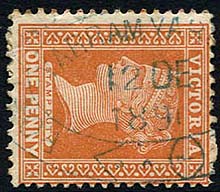 12 December 1891. 12 December 1891. |
||
 |
Yarram Yarram Postal date stamp. 16 February 1921. Commonly used on telegrams. |
||
Comments on Gippsland and the structures which are built must always be placed in the context of the dreadful bush fires which continually ravage the region. Year after year, dreadful stories emerge - even the fires of 7 February 2009 which were the worst in Australia's history:
- 173 people died;
- well over 400 injured;
- 7,562 people displaced; and
- 4,500 square km. burnt out.
It was the eighth deadliest bushfire/wildfire event in recorded history.
The Sydney Morning Herald reported on 5 February 1898 about the fires which were burning then:
"The bush fires now raging in Victoria have reached a record of destruction unprecedented in the history of that colony. The heat on Tuesday attained a point without parallel and from all parts of the forest country, but particularly from Gippsland come thrilling accounts of the ravages of the fires. The settlers outside the towns in these districts have been in most cases hopelessly burnt out, and we got on all sides descriptions of fire-blasted tracts of country and forests ablaze in all directions. The towns themselves are threatened and in some cases partially destroyed. Drouin, for instance, is beleagured by a circle of flame, South Warragul is surrounded, the labour colony at Leongatha has been devastated, and at Korumburra, Traralgon and other places, hundreds of men assisted by their women-folk have been hard at work fighting back the flames from taking complete possession of these centres of settlement. The vast scale and destructiveness of these fires we have already described but the most thrilling part of the story is that which relates to the perils of men, women and children, and the hardy heroism of the fire-fighters who have thus been suddenly called upon to defend themselves and their possessions against an enemy more destructive and pitiless than war itself. We have accustom ourselves to think of the older settled colonies as having progressed beyond the stage of those pioneer perils and difficulties associated with the early struggles of Australian colonisation of which "Black Thursday" is the historic typo. But "Black Thursday" itself has been eclipsed by the havoc now going on and it is well within the truth to say that at no time since Australia has been the home of white men has the story of settlement been illustrated by more stirring incidents of peril, of struggle and of disaster. The one relieving feature of the situation as it is disclosed by the accounts which have reached us is suggested by the manly qualities of self-sacrificing courage and mutual help which these extraordinary circumstances have called forth".
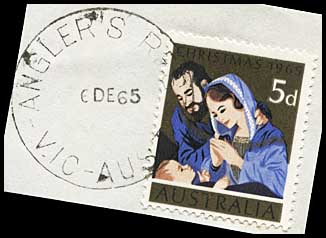
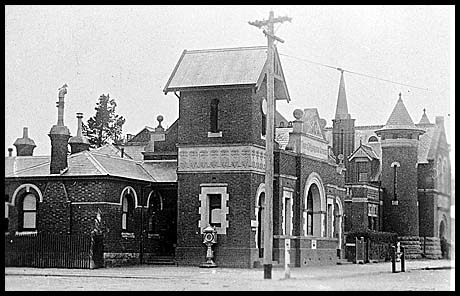

 P&T 1920.jpg)
